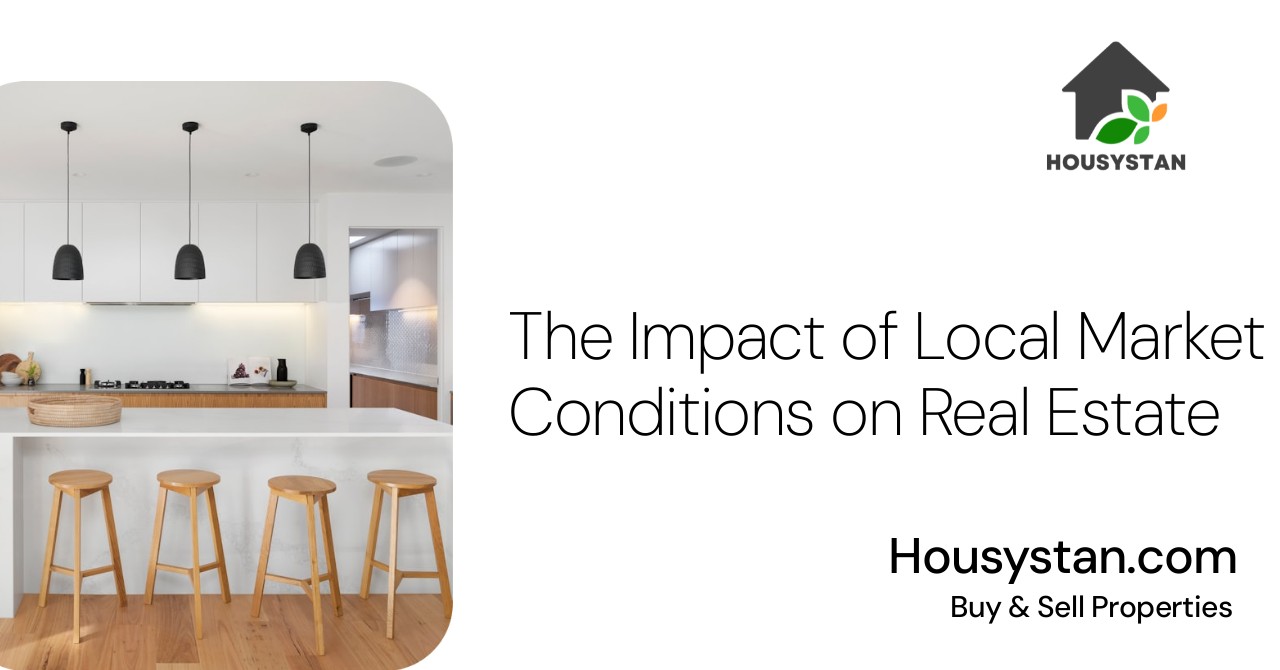The Impact of Local Market Conditions on Real Estate
Read latest blogs and articles from Housystan

The Information mentioned here was last updated on:
28/12/2025The Impact of Local Market Conditions on Real Estate
Real estate is often seen as one of the safest investments. However, understanding the dynamics at play in any real estate market requires an appreciation for local conditions. These influences can significantly affect property values, rental yields, and the overall attractiveness of investing in real estate within a specific area.
Understanding Local Market Conditions
- Verified Tenants/Buyers
- Unlimited Property Listing
- Zero subscription/charges fee
Local market conditions in real estate refer to the economic, social, and environmental factors that influence the housing market in a specific geographical location. Key considerations include:
- Economic Performance: The strength of the local economy, including employment rates and economic growth, directly affects real estate demand. A thriving local economy often leads to more job opportunities, higher income levels, and greater demand for housing.
- Population Trends: Shifts in population size and demographics can dramatically impact real estate markets. Population growth typically increases demand for housing, while a declining population might lead to reduced demand and falling property prices.
- Land Use and Zoning Regulations: Local government policies regarding land use, zoning, and housing regulations can affect the supply and quality of available properties. Stringent regulations could lead to reduced housing supply and increased prices.
- Infrastructure and Amenities: The availability of quality infrastructure, such as roads, public transport, schools, and healthcare facilities, makes a location more desirable. Good infrastructure can boost property values and attract more buyers or renters.
Economic Factors and Real Estate
The local economy has a substantial bearing on the real estate market:
- Employment Opportunities: Areas with robust job markets draw more people looking to purchase or rent homes. High employment levels generate a steady demand for real estate, potentially increasing property prices and rents.
- Income Levels: Rising income levels increase purchasing power, enabling more families to buy homes, thereby pushing up demand and property prices.
- Interest Rates: Although more general than local, interest rate trends can affect local markets by influencing borrowing costs. Lower interest rates can make home loans more affordable, thereby stimulating market activity and boosting property prices.
Social Dynamics and Real Estate
Changes within the local populace can lead to shifting real estate demands:
- Demographic Changes: A growing population of young professionals or an influx of retirees alters the types of properties in demand. Young buyers may seek apartments or starter homes near urban centers, while retirees might prefer quieter, suburban locales.
- Lifestyle Preferences: Increasing interest in sustainable living can attract buyers to areas with green spaces, walkability, and eco-friendly housing options.
Environmental Considerations
The physical environment also affects real estate in many ways:
- Natural Disasters: Areas prone to natural disasters might see a decrease in property values or difficulty in obtaining insurance, impacting real estate demand.
- Climate Change: Flood risks and other climate change effects can deter buyers, whereas regions less vulnerable to extreme weather can become more desirable.
The Impact of Policy and Regulation
Local government policies can play a pivotal role:
- Taxes and Incentives: Property taxes, grants for first-time home buyers, or tax rebates can influence buying decisions and alter demand patterns.
- Housing Development Policies: Initiatives promoting affordable housing or luxury developments can redefine market dynamics, impacting supply, demand, and pricing.
Infrastructure and Amenities
The presence and quality of infrastructure and local amenities lend considerable weight to real estate decisions:
- Transportation Links: Proximity to major highways, efficient public transport systems, and airports make properties more attractive and convenient for potential buyers and renters.
- Schools and Education: Areas with high-rated schools often see increased housing demand, particularly from families seeking quality education for their children.
- Healthcare and Safety: Hospitals, clinics, and low crime rates also contribute to the desirability of an area.
How to Stay Informed
To make informed real estate decisions, staying updated with local market conditions is crucial:
- Local Real Estate Reports and Market Analyses: Regularly review market reports to understand trends, average property prices, and rental yields.
- Networking with Local Realtors: Engage with experienced realtors who can offer insights into market conditions and forecast future trends.
- Community News and Updates: Follow local news outlets and community boards for information that may impact the real estate market, such as new development projects or community planning changes.
Understanding the impact of local market conditions can empower real estate investors, home buyers, and renters to make savvy decisions tailored to their needs and financial goals. Each region has its own set of influencing factors, making it essential to consider these local nuances when entering the real estate market.
Looking for more insights? Discover tips on home buying, renting strategies, and the latest in real estate trends by exploring other sections of our blog.